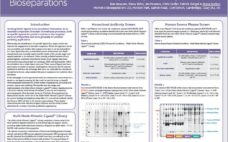Small synthetic ligands have established themselves as an essential component of modern downstream processes, both as specific ligands for product capture or the targeted removal of impurities and more generally for product polishing applications. Historically, the identification of a specific ligand for a target protein has required the engagement of specialist companies. Whilst this approach can be very successful, such studies often require some time to set-up and perform (i.e. from ligand discovery, to adsorbent/process development and finally manufacture) and…
Tuesday, December 20, 2016 Daily Archives
Targeting Desired N-Linked Glycosylation Profiles Through The Use Of Glycosylation Enhancing Feeds And High Throughput And High Resolution N-Glycan Analysis By Multi Capillary Electrophoresis
Glycosylation is a key product quality attribute for many biotherapeutic proteins expressed in CHO cells. N-linked glycans may display macro- and micro-heterogeneity; the degree of this variation can depend on several factors, including cell line, media/feeds, and process. As a consequence, it has often been challenging to achieve and maintain preferred glycosylation profiles from cell culture development through bioreactor scale-up. In order to address these challenges, we have developed a new feed technology in conjunction with a unique fed-batch process…
High Density Culture Strategies For Improved Scalability With Single-Use Systems
Improvements in single-use systems have allowed implementing high-density cultures in standard work flows. The current study shows integration of the Thermo Scientific™ HyPerforma™ Single-Use Bioreactor (S.U.B.) and the XCell™ ATF6 Single-Use (SU) System to achieve high-density cultures. Current results are compared against similar cultures using a stainless steel ATF6 system. The S.U.B. was able to support high-density cultures (>40E06 cells/mL) without modification to standard single-use components and maintained proper operating parameters. Scale-up criteria for both S.U.B. and ATF are provided…
Rapid and Simple Sample Preparation for High Throughput, High Resolution and Sensitive Glycan Analysis by Capillary Electrophoresis
Here, we report the simple and rapid GlycanAssure™ workflow that combines high throughput and high resolution glycan analysis of 96 samples in 7-9 hours using Applied Biosystems™ 3500xL 24-capillary electrophoresis system. The process eliminates vacuum drying and highly toxic cyanoborohydride in the labeling reaction. Use of Dynabeads™ magnetic beads for glycan purification post deglycosylation and removal of free dyes after labeling streamlines the process for automation. Capillary electrophoresis can detect less than 0.2 fmol/ÎĽL of labeled glycans. Two proprietary fluorescent…
Innovative Hydrophobic Interaction Chromatography (HIC) Resins for Next Generation Molecule Challenges
Advances in biotherapeutics are generating a wider range of biomolecules that are presenting unique and often difficult separation and purification challenges. Based on the complex needs of the industry a series of HIC prototypes were developed over a range of hydrophobicity. Utilizing extensive user input, design goals focused on development of resins with market leading resolution and capacity, as well as optimized surface and flow characteristics for increased throughput and high product recovery. All of which are typical pain points…





